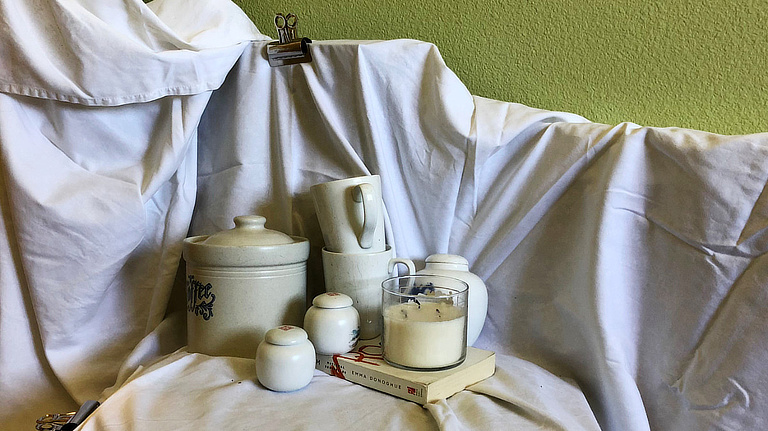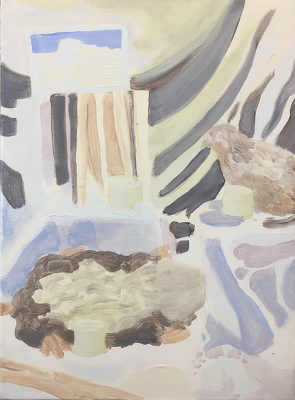Prompt
Create and paint a still life using only white objects.

Supplies
Still Life Items
White objects: bed sheets, bottles, cups, bowls, folded or crinkled paper, candles, rocks, soap, clothing, rice, eggs, etc.
Palette Colors
- Titanium White
- Cadmium Yellow
- Alizarin Crimson
- cadmium Red
- Ultramarine Blue
- Raw Umber
- Raw Sienna
- Hansa Yellow
- Pthalo Blue
Step 1
Collect white objects for your still life.

Step 2
Arrange the objects on a table against a wall. Hang a cloth up on the wall behind the table for a backdrop. Be inventive with your still life! Stack, overlap, and place the objects in a dynamic way.

Step 3
Set up your light source. You could use a clamp light or desk lamp to illuminate your objects and create dynamic shadows.

Step 4
Mix your colors. With each cup of white, mix only a tiny pebble’s worth of color.


Suggested mixtures
Cup #1: titanium white + cadmium yellow
Cup #2: titanium white + phthalo blue
Cup #3: titanium white + alizarin crimson
Cup #4: titanium white + hansa yellow + black
Cup #5: titanium white + yellow ochre
Cup #6: titanium white + cadmium red* + ultramarine blue* + raw umber
Cup #7: titanium white + ultramarine blue
Cup #8: raw sienna
Cup #9: ultramarine blue
Cup #10: slow dry medium
Step 5
Make several thumbnail sketches of your still life to work out your final composition.


Step 6
On a large piece of Bristol board, using a pencil, loosely sketch the composition of your photo. Block in all the walls, floor, ceiling, and large objects, and don’t worry about details.
Step 7
Block in the biggest shapes of your composition with a 1” flat brush and your white mixtures.
Step 8
Observe the light on each object, and how the highlights bend toward a particular color. This will help guide you towards which of your white mixtures to use.

Step 9
On your freezer paper, mix shadow tones. For each blocked shape on your canvas, take a small amount of one of your white mixtures and mix it with a bit of raw sienna and ultramarine blue.

Step 10
Paint the shadows using a ½” brush. Use a ¼” – ½” brush dipped in the slow dry medium to blend your shadows. You may need to add more of your corresponding white onto the canvas to get a smoother blend.

Step 11
Using a ¼” – ½” brush, add smaller highlights with your mixed whites. Blend these areas as well.

Tips
- See our Still Life Tutorial for more on how to set up a fun and visually dynamic still life.
- Ultramarine blue will push your shadows to be cooler. Raw sienna will push your shadows to be warmer. Mixing in equal parts of the ultramarine blue and raw sienna will create a neutral shadow. Learn about warm & cool colors here.
- Add small amounts of color at a time. It’s easier to add more color, than to backtrack to the original color.
- If your paint dries faster than you want, add slow dry medium.
- Keep your brushes in water as you work so they are easier to clean later!
Responses
“When I was organizing the objects to use, I came up with the idea to make a coltish scene that includes the body of a girl and the bones of the beast that killed her. This painting in was especially interesting because I had to figure out a balance between the lightness of the objects in the still life and the dark theme I wanted to convey.”
Mia Rozear


“I had to think about the reflected light on the white objects and see past the surface level tone. I often over-exaggerated the tints of the shadows and highlights by making them much more saturated with either a cool tint or warm tint or somewhere in between, which helped to make the piece more dynamic.
Anya Chen
“Layering a white pot with a white cup on top of a white background forced me to look harder at what I was seeing and question it. It made me see color in the different objects and their relationships to the others in ways I didn’t really pay attention to before. I started painting with darker more exaggerated colors because it made it easier for me to bring out certain objects. But I think something I could’ve altered was the amount of exaggeration just because I think it changed the way the still life actually looks.
Cindy Qiao



